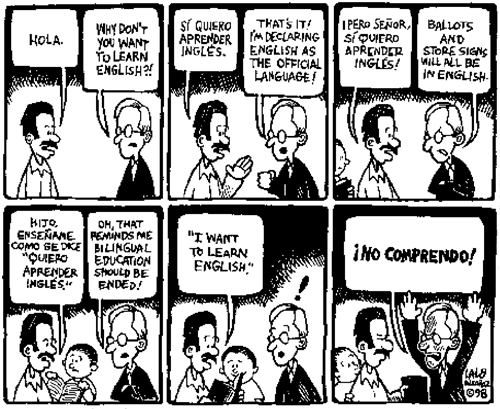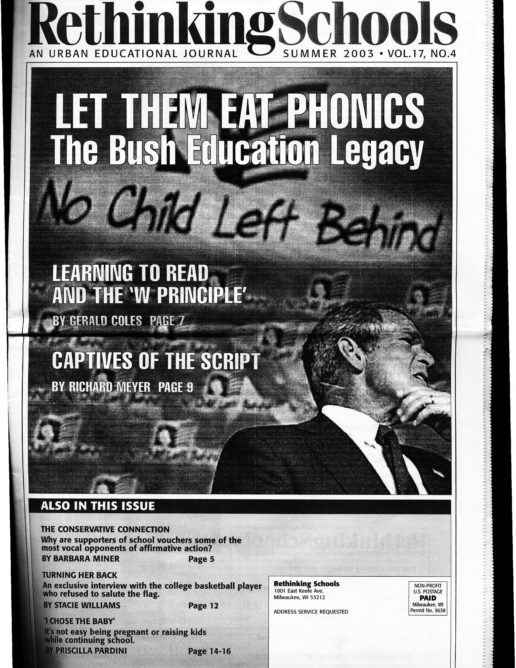Student Clubs
A former high school teacher recalls how his students put classroom lessons into action
Illustrator: Aaron McGruder

-photo: Aaron McGruder
Following the events of Sept. 11, 2001, government leaders, with the support of the media, have used fear and innuendo to promote an uncritical patriotism. But active citizenship in a democratic society requires critical thinking and the constant questioning of authority. This is something that teachers can model for students, both in the classroom and in extracurricular activities.
As a former New York City high school teacher and a social studies educator in the teacher education program at Hofstra University on Long Island, New York, I spoke recently at workshops and assemblies about the war. I found that some teachers and students did not understand their right to disagree with and protest against government policies.
Teachers worried about the issue of neutrality. They wanted to know, “Do we have the right to express our own points of view in class?” A few asked how they could involve their students in political action. Students wondered if they would still have the right to protest after the war started.
I often discussed my own experience as a high school teacher organizing students in public schools to be political activists around different social issues. These included campaigns between 1978 and 1993 against cuts in school budgets, against U.S. military interventions in Central America, in opposition to apartheid in South Africa and racial violence in our community, and in support of reproductive freedom, abortion rights, and condom availability.
AGENTS FOR CHANGE
One of my primary goals as a high school social studies teacher was to empower young people so that they could become active citizens and agents for democratic social change. I encouraged them to think about issues and to learn how to collect, organize, analyze, and present information and their own ideas.
This approach requires that teachers be part of – but not dominate – classroom discourse, and it means being willing to express views on controversial issues. Everyone has a point of view, and it is much more honest to present it than to try to keep it hidden below the surface. Rather than neutrality, our goal should be open, honest, and respectful dialogue.
Many new teachers without tenure are afraid that if they involve students as political activists, they will jeopardize their positions. While I do not want to minimize this concern, I want to present a model I was able to use effectively to engage students as activists.
The Forum Club was an independent student group chartered by the student government. It sponsored studentled forums on controversial issues, prepared testimony for public hearings, wrote position papers for publication in local newspapers, and organized student and community support for a school-based public health clinic. Usually, the students who joined the club were from my classes, but they also involved their friends. In addition, as the club gained a reputation in the school, new students would come to meetings to raise their own issues. As a result, one year the Forum Club sponsored a bulletin board display on gays and lesbians in history and, on another occasion, helped Islamic students organize a meeting to address stereotypes about their religion.
In general, the Forum Club provided students who were excited by classroom discussions of social justice and democratic rights – or who were upset by events in our school – with a place where they could further explore their questions and act based on their beliefs. As the club’s faculty advisor, I was able to both encourage students to see themselves as activists and to help them learn through experience how to organize for social change.
As a chartered student group, the Forum Club was entitled to receive some school funds; to do fundraising in school; to distribute a newsletter and leaflets; to hang up posters; to make and sell political buttons; and to use rooms, copying machines, and computers. It gave us access to other students, the ability to meet with parent groups, and the right to send speakers to classes to report on club activities. An elected executive committee met regularly (sometimes daily during heated campaigns) and we tried to hold monthly meetings of the full club. Students actually received community service credit for their political involvement.
As a student club, the Forum Club had to have a clear educational purpose. Our educational goals included making reasoned decisions based on an evaluation of existing evidence, researching issues and presenting information in writing and on graphs, exploring the underlying ideas that shape our points of view, giving leadership by example to other students, and taking collective and individual responsibility for the success of programs. Significantly, all of these are part of the New York State civics and citizenship standards. To promote academic achievement, as well as to help students present their ideas, club members continually put their opinions into writing and edited each other’s work. One collective essay, accusing a local newspaper of bias in its negative coverage of pro-choice demonstrations, was published on its op-ed page.
Being an official student club also saddled us with responsibilities, but they were not onerous. Students had to abide by school rules. We had to be willing to discuss plans and handouts with school administrators, and students had to get parental permission to participate in after-school or weekend activities. We tried to get as much publicity for the club as possible on television and in mainstream and community newspapers. Once the entire club appeared on a cable television program to discuss its opposition to laws requiring “parental consent” before teenagers could receive abortions. Club members were quoted in local newspapers when they testified at public hearings in favor of making condoms available to students in public high schools.
INVITED SPEAKERS
Despite efforts to be responsible, we were not completely protected from interference. On occasions when we invited a Sandinista mayor of a Nicaraguan town and a representative of the African National Congress to speak at the school, the social studies supervisor suggested that students prepare “fact sheets” that presented alternative views (though we never did figure out what an acceptable “alternative view” of apartheid entailed). During a schoolwide campaign in support of reproductive freedom and condom availability, we were asked to invite an anti-abortion speaker to balance a presentation by the National Organization of Women. Preparation for this meeting was an opportunity for students to discuss issues and sharpen their ideas. A small group of “pro-life” students affiliated with the club acted as hosts, while other students raised questions and presented their views during the course of debate. Some anti-abortion teachers tried to take over the discussion, but the student moderator made it clear that she would call on people and that students would speak first.
Once the school district pressured us to cancel a club trip to Washington to participate in a pro-choice demonstration. But the administrators withdrew their request when the club threatened to take the issue to the newspapers. However, the club’s leadership agreed to take a supportive school administrator on the trip to ensure its educational legitimacy.
My role as faculty advisor to the club meant I had to put the students’ decisions ahead of my own views. Sometimes, when students did not agree with my ideas, I had to back off. For example, during the first Gulf War, the club decided not to participate in anti-war activities while troops were involved in military conflict. And I felt it was important to keep the students’ needs in the forefront: I chose not to bring students to a local rally against racial violence because we heard there would be hostile counter-demonstrators.
Since I have shifted to the university, Michael Pezone, one of my former teacher education students, has successfully used his own variation of the Forum Club model to promote student activism. During the Fall 2001 semester, in response to the destruction of the World Trade Center, the New York City Board of Education required all public schools to lead students in the Pledge of Allegiance at the beginning of each school day and at all schoolwide assemblies and school events. Mike’s students contacted the New York Civil Liberties Union to clarify legal issues and learned that participation was not required by law. In response, they distributed a circular encouraging students to behave respectfully and responsibly during the pledge, informing them of their legal right not to participate, and asking them to report violations of the law. The next year Mike’s students organized a student petition and protest against metal detectors that were making them late to class in the morning.
I have not seen or heard from most of the students involved in the Forum Club’s activities in at least a decade. But over the years I have learned about a few of them. One, a recent Dominican immigrant who was just beginning to learn English when he was in my class, helped organize livery drivers into a union. Another became a lawyer and activist in the local South Asian community. A third, after graduating from college and medical school, took a position at UNESCO that allowed her to promote public health around the world.
Finally, one became an English teacher who works with recent Latino immigrants from Central America. I believe their experiences as activists in high school played a role in their later choices and validate this approach to helping students organize for social change.

